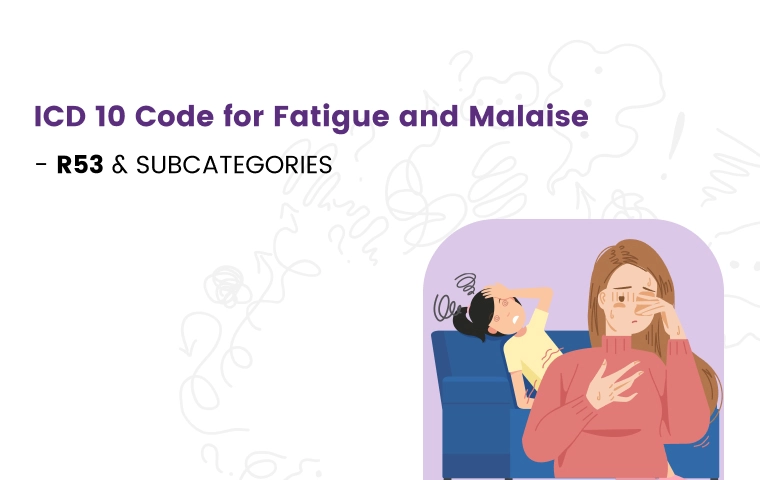Fatigue and malaise – these common yet often elusive complaints can be a puzzle for healthcare providers and a headache for medical billers. Accurately capturing these symptoms in your documentation and coding is essential for proper patient care and appropriate reimbursement. That's where understanding the ICD-10 codes for fatigue and malaise becomes crucial.
In this detailed guide, we'll break down ICD-10 code R53 and its subcategories, giving you the confidence to diagnose, document, and code these symptoms accurately. This will help you ensure the best possible outcomes for your patients and accurate claims for your practice.
What ICD 10 Code Should You Use for Fatigue and Malaise?
The primary ICD-10 code for fatigue and malaise is R53. However, this code is not as simple as it may seem at first glance. R53 itself is a broad category encompassing a variety of related symptoms and conditions, each with its own specific code. Let's take a closer look:

R53.0: Neoplastic (malignant) related fatigue - This subcategory is used when fatigue is a direct result of cancer or cancer treatment.
R53.1: Weakness - This code signifies a general feeling of weakness without a specified cause.
R53.2: Functional quadriplegia - This code refers to a condition where all four limbs are weak or paralyzed due to a functional disorder, not a physical injury.
R53.8: Other malaise and fatigue - This is a catch-all category for fatigue and malaise not otherwise specified, and it's further divided into:
-
R53.81: Other malaise
-
R53.82: Chronic fatigue, unspecified
-
R53.83: Other fatigue
Why Choosing the Right ICD 10 Code for Fatigue and Malaise?
While R53 is your primary tool for coding fatigue and malaise, several factors can influence your final coding decision. Selecting the most appropriate code depends on the specific details of the patient's condition.
1. Underlying Cause
If fatigue or malaise is a symptom of another diagnosed condition – such as anemia (D64.9), kidney disease (N18.9), depression (F32.9), or even medication side effects – you'll need to use an additional code alongside R53 to reflect the primary diagnosis accurately. This means listing the code for the underlying condition first, followed by the appropriate R53 code to capture fatigue and malaise as secondary symptoms.
Example: A patient with chronic kidney disease (N18.9) experiencing fatigue would be coded as N18.9 (primary) and R53.82 (secondary).
2. Specificity
Always strive for the most specific code that accurately describes your patient's symptoms. For instance:
-
If the fatigue is clearly related to cancer treatment, use R53.0 (neoplastic-related fatigue) instead of the broader R53 code.
-
If fatigue persists for an extended period after a viral infection, R53.1 (postviral fatigue syndrome) may be more appropriate.
By selecting the most precise code, you paint a clearer picture of your patient's condition for both medical and billing purposes.
3. Documentation
Thorough documentation in the patient's medical record is the cornerstone of accurate coding. It provides the necessary evidence to support your code choices and justify them to insurance payers. When documenting fatigue and malaise, include details like:
-
Severity: How much is fatigue or malaise impacting the patient's daily life? Is it mild, moderate, or severe?
-
Duration: How long has the patient been experiencing these symptoms?
-
Contributing factors: Are there any potential causes for the fatigue or malaise, such as recent illness, medication use, or underlying medical conditions?
Clear, detailed documentation not only strengthens your coding accuracy but also helps guide the patient's care plan and facilitates communication with other healthcare providers.
Coding for Chronic Fatigue
Chronic fatigue, often associated with complex conditions like chronic fatigue syndrome (CFS) or myalgic encephalomyelitis (ME), presents a unique coding challenge. Before 2023, chronic fatigue fell under the broader R53.82 category. However, recent updates to the ICD-10-CM have introduced more specific codes for these conditions, marking a significant shift in how we document and bill for chronic fatigue.
New Codes for 2023 and Beyond
As of October 1, 2023, the following codes are available for coding chronic fatigue:
-
G93.31: Postviral fatigue syndrome
-
G93.32: Myalgic encephalomyelitis/chronic fatigue syndrome (ME/CFS)
-
G93.39: Other post-infection and related fatigue syndromes
These new codes offer greater specificity, allowing for more accurate diagnosis and tracking of chronic fatigue conditions. It's important to note that R53.82 is still a valid code, but it's now considered unspecified and should only be used when a more specific code doesn't apply.
Choosing the Right Code for Chronic Fatigue
The appropriate code for chronic fatigue depends on the specific diagnosis and underlying cause.
-
G93.31 (Postviral fatigue syndrome): This code is used when fatigue persists for more than six months after a viral infection, meeting specific diagnostic criteria.
-
G93.32 (ME/CFS): This code is used for cases meeting the diagnostic criteria for ME/CFS, a complex condition characterized by profound fatigue, cognitive dysfunction, sleep disturbances, and other symptoms.
-
G93.39 (Other post-infection and related fatigue syndromes): This code is used for fatigue syndromes that don't fit into the previous categories but are believed to be related to a past infection.
Final Words
Coding for fatigue and malaise may seem complex, but you've got this! We've covered the basics – from understanding ICD-10 code R53 and its subcategories to choosing the most specific code for each case.
Remember, accurate coding isn't just about following rules. It's about standing up for your patients. When you code correctly, you make sure they get the right care and support. So, stay in the loop about any coding changes, keep learning, and always write clear, detailed notes in your patients' records. This will not only help you get paid what you deserve, but it will also help your patients feel better and make healthcare better for everyone.
ABOUT AUTHOR

John Wick
As a blog writer with years of experience in the healthcare industry, I have got what it takes to write well-researched content that adds value for the audience. I am a curious individual by nature, driven by passion and I translate that into my writings. I aspire to be among the leading content writers in the world.
